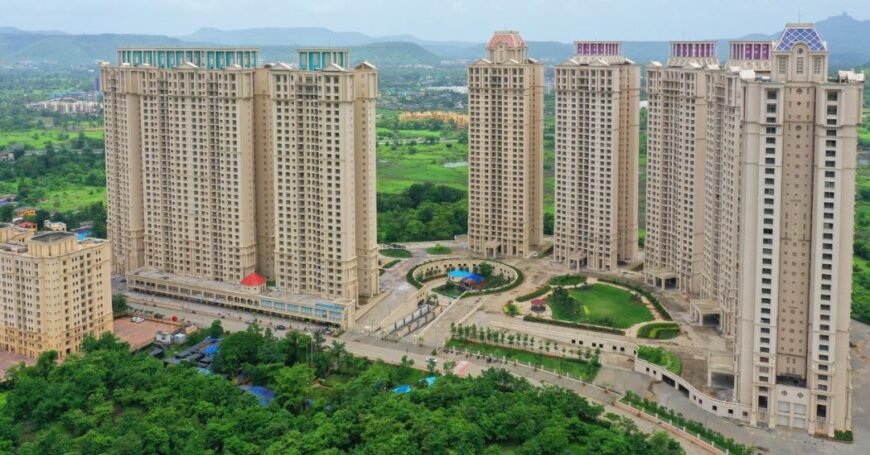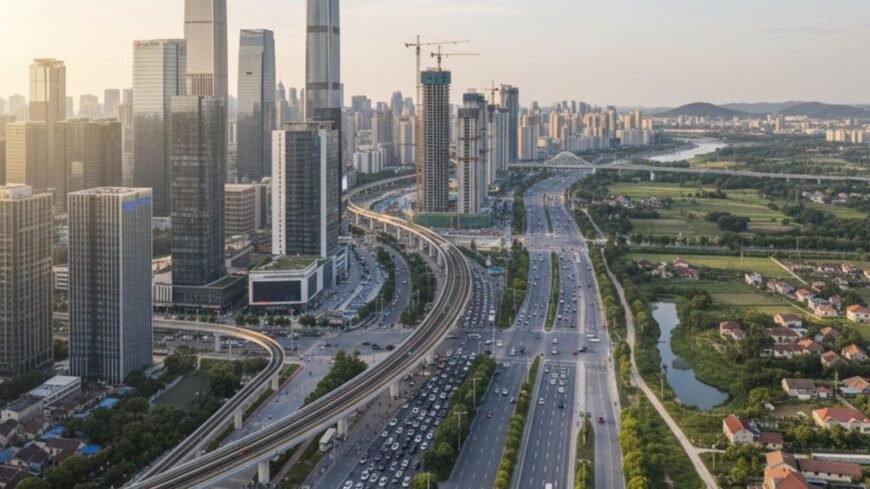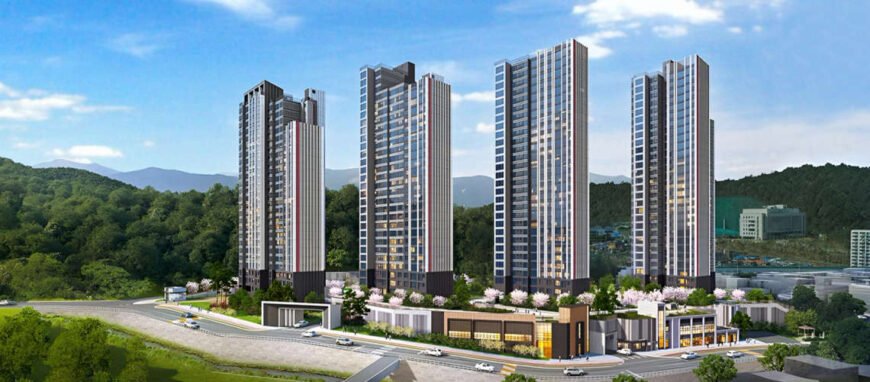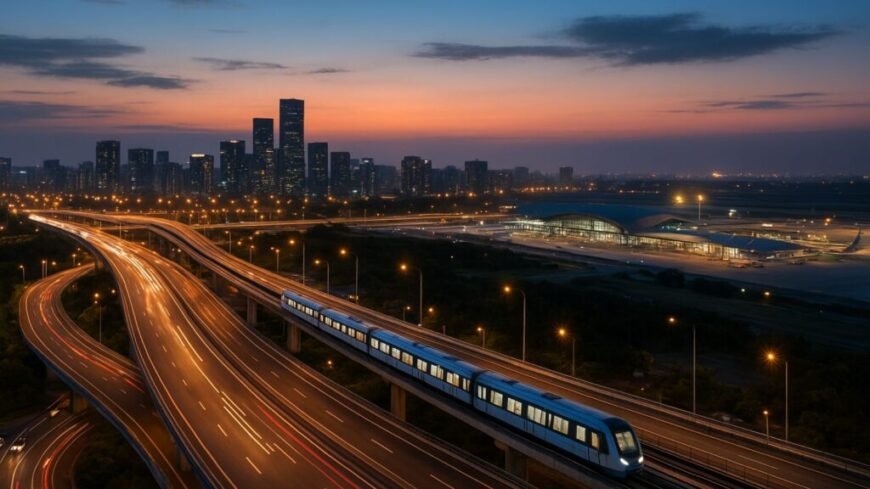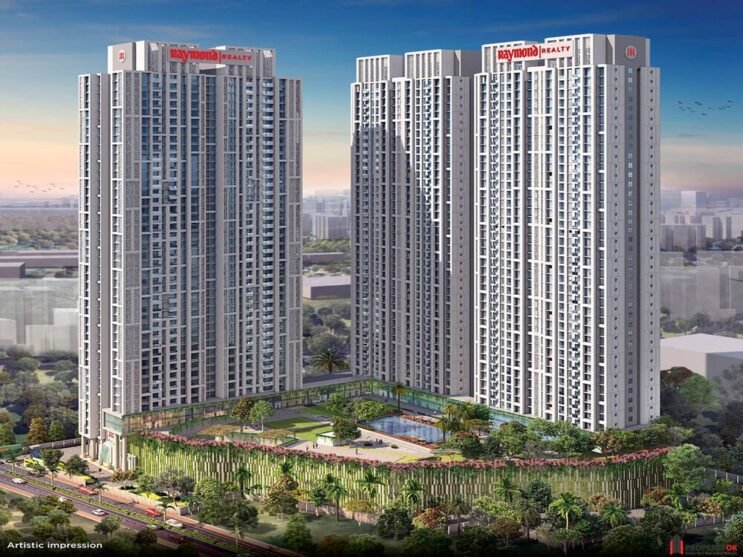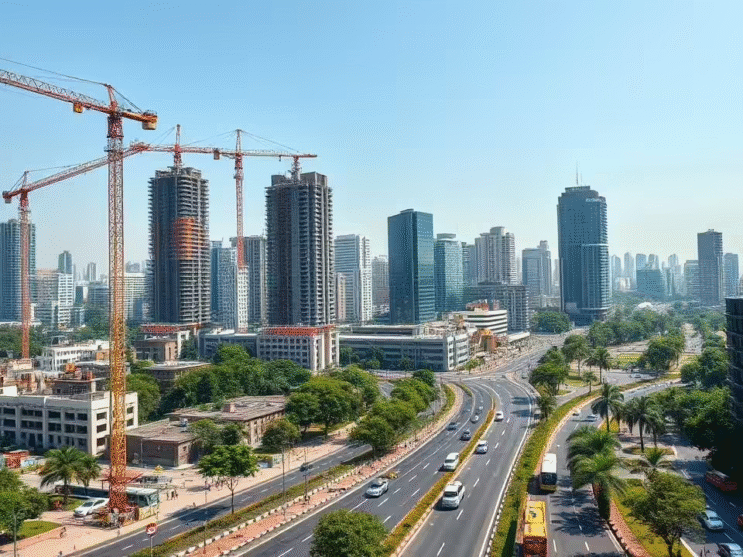India’s Real Estate Crisis: Why Homeownership is Slipping Away
Table of Contents
India’s Real Estate Crisis: Rising Prices, Fading Dreams
India’s real estate sector has always been a symbol of aspiration, but in recent years it has become a reflection of inequality and rising stress. In metros like Gurugram, luxury apartments worth ₹100–200 crore are sold out quickly, yet during monsoons, these same localities face waterlogging, traffic chaos, and poor infrastructure. Cities such as Mumbai, Bengaluru, and Delhi are no different. Despite these glaring problems, property prices continue to soar, making homeownership an increasingly distant dream for the middle class.
At Urvik Consulting, we analyze the underlying data to understand why Indian real estate has become so expensive, whether a market correction is likely, and what solutions might pave the way for a more balanced housing market.
Housing Affordability: The Price-to-Income Ratio
The price-to-income ratio is one of the most reliable indicators of housing affordability. It calculates how many years of household income are required to buy a home.
For instance, if a family earns ₹20 lakh annually and the property costs ₹1 crore, the ratio is 5. Globally, a ratio of 5 or below is considered affordable.
In India, however, the scenario is alarming:
- India Average (2024): 7.5 → 8.8 (in just one year)
- Mumbai: 15.1
- Delhi: 12.3
- U.S. Average: 4.8
This means housing in Indian metros is nearly unaffordable compared to international benchmarks.
Rental Yield: A Weak Investment Case
Another crucial metric is rental yield, which shows the annual rent earned as a percentage of the property price.
- Global Average: 6–8%
- U.S. Average: 8–12%
- India Average: 2–4%
Clearly, buying property in India offers poor rental returns. For many investors, the only incentive remains speculative gains, not long-term rental income.
Why is Real Estate So Expensive in India?
Several structural and economic factors are driving property prices upwards:
1. Urban Migration and Limited Land
Around 37% of Indians live in cities, compared to 66% in China. As people move to metro hubs for jobs, demand for housing rises sharply, while land availability remains restricted.
2. Rising Construction Costs
Over the last five years, costs have surged:
- Cement & steel prices: up 35–57%
- Copper: up 91%
- Labor costs: up 150% since 2019
These increases directly push property prices higher.
3. Shortage of Affordable Housing
India faces a shortage of 94 lakh affordable homes, projected to rise to 3 crore in the next five years. Interestingly, luxury housing sales have grown by 450%, showing a widening gap between demand and supply.
4. High Taxes & Regulatory Charges
Nearly 50–55% of a property’s cost goes into taxes and fees, including GST, registration, FSI charges, and permissions.
5. Black Money & Speculation
Real estate is a popular channel for parking unaccounted wealth. Multiple property purchases purely for investment inflate demand artificially, worsening the affordability crisis.

Will India’s Real Estate Market Crash?
At first glance, the inflated prices may look like a bubble waiting to burst. However, a major crash is unlikely in the near term.
Why?
- Demand in urban areas is still very strong.
- Supply remains limited due to land and regulatory constraints.
- Population growth and urban migration continue to fuel housing needs.
Instead of a sharp crash, minor price corrections in select markets are more probable.
Possible Solutions for a Balanced Market
Addressing India’s real estate challenges requires joint efforts from government bodies, policymakers, and private developers. Some possible steps include:
- Develop Tier-2 & Tier-3 Cities – Creating job hubs in smaller cities can reduce pressure on metros.
- Tax Incentives for Affordable Housing – Lowering GST and registration charges for affordable homes can improve accessibility.
- Strengthen Infrastructure – Better public transport and drainage systems can enhance liveability and reduce metro congestion.
- Curb Black Money – Transparent transactions and strict monitoring can reduce speculative demand.
Conclusion
India’s real estate crisis is a result of multiple interlinked factors – rising construction costs, limited land, poor rental returns, and speculative investments. For the middle class, owning a home is no longer just about aspiration, but survival against mounting challenges.
At Urvik Consulting, we believe that balanced urban development, affordable housing initiatives, and transparent policies are the way forward. Unless addressed, the gap between luxury real estate and affordable housing will continue to widen, pushing the dream of homeownership further away for ordinary Indians.
Understanding Tier 1, Tier 2, and Tier 3 Cities in Real Estate Growth
Table of Contents
India’s real estate sector is one of the fastest-growing markets in the world, shaped by rapid urbanization, infrastructure upgrades, and evolving lifestyle aspirations. To navigate this dynamic landscape, cities are often classified into Tier 1, Tier 2, and Tier 3 categories—a framework that helps investors, developers, and homebuyers assess opportunities and risks effectively.
At Urvik Consulting, we believe this classification is more than just a demographic measure. It’s a strategic lens through which stakeholders can evaluate market maturity, growth potential, and long-term investment viability.
In this article, we break down the characteristics of each city tier, their role in India’s real estate growth story, and why this understanding is critical for making informed property decisions.
What Are City Tiers in Real Estate?
City tiers are indicators of urban development, economic strength, and real estate potential. They highlight differences in population density, infrastructure quality, employment opportunities, and lifestyle patterns.
- Tier 1 Cities → Established metros with highly mature real estate markets, premium property values, and strong economic ecosystems.
- Tier 2 Cities → Fast-developing hubs with expanding infrastructure, rising affordability, and growing investment potential.
- Tier 3 Cities → Smaller urban centers with lower costs, untapped opportunities, and significant long-term growth prospects.
For investors and developers, understanding these tiers ensures smarter strategies—balancing stability, affordability, and scalability.

Tier 1 Cities: The Powerhouses of Real Estate
Tier 1 cities—such as Mumbai, Delhi, Bengaluru, and Hyderabad—are the economic engines of India. They boast advanced infrastructure, diverse employment opportunities, and strong demand across both residential and commercial segments.
- For Homebuyers: Premium apartments, integrated townships, and lifestyle-centric communities.
- For Investors: Consistent returns, high liquidity, and long-term appreciation, albeit with steep entry costs.
- For Developers: Limited land availability drives vertical growth and innovative commercial spaces, including co-working hubs and premium office towers.
While Tier 1 markets are competitive and saturated, their economic resilience continues to attract large-scale investments.
Tier 2 Cities: The Growth Drivers
Tier 2 cities—such as Lucknow, Jaipur, Coimbatore, and Indore—are now recognized as the growth engines of Indian real estate. Positioned between the saturated metros and emerging towns, they offer a balance of affordability and modern infrastructure.
Key growth enablers include:
- Infrastructure upgrades: Metro networks, expressways, airports, and smart city projects.
- Affordability factor: Lower property prices compared to Tier 1, attracting middle-class buyers.
- Commercial demand: Expansion of IT parks, co-working spaces, and retail malls.
- Policy push: Government schemes and incentives accelerating urban development.
For investors, Tier 2 markets provide high potential for value appreciation over the next decade, with relatively lower risks compared to Tier 3 cities.
Tier 3 Cities: The Emerging Frontiers
Tier 3 cities—smaller towns with evolving infrastructure—are increasingly becoming the next frontier of real estate expansion.
- Affordability: Low land and housing costs make them attractive for first-time buyers and early-stage investors.
- Connectivity improvements: Highways, regional airports, and rail networks are slowly bridging the gap with larger cities.
- Sectoral drivers: Education, healthcare, and retail are spurring localized demand.
However, investors should note that Tier 3 markets come with higher risks—slower appreciation, lower liquidity, and dependence on long-term infrastructure growth. A patient investment outlook is essential here.
Why City Classifications Matter
Understanding the tier framework is crucial for all stakeholders:
- Homebuyers → Identify markets that balance affordability with quality of life.
- Investors → Diversify portfolios by combining Tier 1 stability with Tier 2 and Tier 3 growth opportunities.
- Developers → Align project pipelines with demand trends and regional market needs.
Comparing the Tiers at a Glance
| Parameter | Tier 1 | Tier 2 | Tier 3 |
|---|---|---|---|
| Market Maturity | Highly developed | Rapidly developing | Emerging, early-stage |
| Property Prices | High | Moderate | Low |
| Infrastructure | Advanced | Growing | Basic, improving |
| Investment Risk | Low | Moderate | High |
| Demand Drivers | Lifestyle, commerce | Affordability, quality of life | Affordability, untapped market |
Conclusion
India’s real estate landscape is not uniform—it’s a diverse ecosystem where each city tier offers unique opportunities and challenges.
- Tier 1 cities → Stability, liquidity, and premium lifestyle investments.
- Tier 2 cities → Balanced affordability, strong growth trajectory, and rising investor interest.
- Tier 3 cities → High potential for early movers, best suited for long-term strategies.
At Urvik Consulting, we help clients decode these dynamics with data-driven insights and strategic advisory. Whether you’re a developer exploring new markets, an investor building a diversified portfolio, or a homebuyer seeking the right balance of affordability and lifestyle, our expertise ensures you make decisions aligned with long-term goals.
Where to Buy a ₹1 Crore Home in Thane Real Estate Market
Table of Contents
Once considered a satellite town to Mumbai, Thane has transformed into a thriving residential hub within the Mumbai Metropolitan Region (MMR). Thanks to robust infrastructure, improving connectivity, and competitive pricing, the city has emerged as one of the most sought-after housing destinations.
For buyers with a budget of around ₹1 crore, Thane offers multiple options — from compact 1 BHK units in prime areas to 2 BHK and even select 3 BHK apartments in upcoming neighborhoods. Compared to Mumbai’s suburban pockets where prices are far higher, Thane continues to deliver better value for money without compromising on lifestyle.

Why Thane is a Smart Choice for ₹1 Crore Homes
- Connectivity: The city is strategically connected via the Eastern Express Highway, Ghodbunder Road, and upcoming metro corridors, making it ideal for daily commuters to Mumbai and Navi Mumbai.
- Affordability vs Mumbai: While a ₹1 crore budget in Mumbai often restricts buyers to smaller units in distant suburbs, Thane offers more space and modern amenities.
- Future Growth: Upcoming projects like the Thane-Borivali tunnel, new metro lines, and enhanced links to Navi Mumbai are expected to further boost property demand and values.
- Balanced Lifestyle: With its mix of urban infrastructure, business hubs, and green spaces, Thane has become an attractive choice for professionals, families, and investors alike.
Property Trends in Thane Around ₹1 Crore
According to real estate data, 65,800 housing units were launched in Thane between FY 2020 and FY 2025. Interestingly, 42% of these launches were 1 BHKs, followed by 45% in 2 BHKs, indicating strong demand for compact, affordable homes.
Pricing Snapshot:
- Naupada & Pokhran 2: A 1 BHK (400–450 sq. ft.) is priced at around ₹1 crore.
- Kolshet Road, Ghodbunder Road, Kasarvadavli, Vartak Nagar: Offer 1 BHKs (450–550 sq. ft.) in the ₹90 lakh–₹1 crore range, appealing to first-time buyers.
- Anand Nagar & Bhayandarpada: Similar-sized 1 BHKs are available for ₹50–60 lakh, offering budget alternatives.
- Kasarvadavli & Surrounding Pockets: Standalone older buildings may offer compact 3 BHKs (~900 sq. ft.) for ₹1–1.10 crore.
- Kalyan & Dombivli (Thane District): Buyers can find larger 3 BHKs (1000–1200 sq. ft.) from leading developers like Lodha and Runwal within the same ₹1 crore bracket.
For those seeking long-term appreciation, central Thane pockets like Naupada, Pokhran 2, and Hiranandani Estate remain premium, while Ghodbunder Road and Kolshet continue to attract mid-segment buyers.
Top Projects Offering ₹1 Crore Homes in Thane
1. Hiranandani Estate, Thane
Spread across 250+ acres, Hiranandani Estate is one of Thane’s most prominent integrated townships.
- 1 BHK Pricing: Around ₹90 lakh to ₹1 crore (400 sq. ft. approx.)
- Amenities: Clubhouses, swimming pools, sports courts, landscaped gardens, schools, hospitals, and a retail high street.
- Connectivity: Seamless access via Ghodbunder Road, close to EEH and Mumbai’s Western suburbs. Powai is ~1 hour away, and the airport is within 60–120 minutes depending on traffic.
- Lifestyle: Spacious apartments, semi-modular kitchens, premium bathroom fittings, and wide green landscapes make it ideal for families.
2. Raymond Realty, Thane
A large-scale township development spread across 100 acres, Raymond Realty has quickly become one of Thane’s landmark residential addresses.
- 1 BHK Pricing: Approx. ₹1 crore (400 sq. ft.)
- Amenities: 40–50 lifestyle features, including swimming pools, yoga zones, landscaped gardens, and high-street retail.
- Connectivity: Just 15–20 minutes from Thane Railway Station, with upcoming metro stations nearby. Excellent access to EEH and Ghodbunder Road.
- Design: Modern interiors with vitrified flooring, French windows for natural light, and modular kitchen setups.
Investment Outlook – Is ₹1 Crore Enough in Thane?
Yes, Thane continues to offer strong opportunities for homebuyers and investors with a ₹1 crore budget. While Mumbai prices often push buyers to compromise, Thane delivers well-connected locations, branded projects, and lifestyle amenities at relatively lower costs.
For compact homes, buyers can look at Naupada, Pokhran 2, and Kolshet Road, while those seeking larger 2–3 BHK units can explore Kalyan, Dombivli, or older standalone buildings in Thane West. With future-ready infrastructure and continuous demand, property values in Thane are expected to remain on an upward trajectory.
Final Thoughts
A ₹1 crore home in Thane is not just about affordability; it represents access to a balanced lifestyle, better space efficiency, and long-term investment potential. With premium projects like Hiranandani Estate and Raymond Realty offering world-class amenities, and affordable options available in emerging corridors, Thane provides choices for every type of homebuyer.
For those looking to strike the right balance between budget, location, and lifestyle, Thane stands out as one of the best places to buy a home in the MMR today.
Rental Income Opportunities: Is Thane the Next Big Destination?
Table of Contents
For decades, Mumbai has been the financial capital and the most sought-after location for property buyers and investors. However, rising prices and limited space have pushed both end-users and investors to look beyond Mumbai—and one city that has emerged as a frontrunner is Thane. Known as the “City of Lakes,” Thane has transformed into a modern urban hub, offering excellent infrastructure, lifestyle amenities, and growing real estate prospects.
Today, investors are keenly eyeing rental income opportunities in Thane, and for good reason. With affordable yet premium housing options, improved connectivity, and strong tenant demand, Thane is proving to be one of the most lucrative real estate markets in 2025.
Why Thane is Attracting Tenants
1. Affordability Compared to Mumbai
Property prices in Mumbai have reached record highs, making rentals expensive and ownership unaffordable for many. Thane, on the other hand, offers larger and better-designed homes at a fraction of Mumbai’s price. For tenants, this means a chance to live in spacious 2BHK or 3BHK apartments at the cost of a compact 1BHK in Mumbai suburbs.
2. Improved Connectivity
Connectivity has always been a major concern for tenants. Thane has addressed this with massive infrastructure upgrades. The upcoming Mumbai Metro Line 4, the Eastern and Western Express Highways, and Thane’s strong suburban railway network make commuting to Mumbai, Navi Mumbai, and even Pune seamless. This has significantly boosted rental demand in the region.
3. Lifestyle Upgrades
Thane is no longer just a residential town—it is a complete lifestyle destination. With world-class schools, reputed hospitals, IT parks, shopping malls, multiplexes, and fine dining restaurants, tenants find everything they need within city limits. This has made Thane particularly attractive to young families and professionals.
4. Greener and Spacious Living
Unlike congested Mumbai, Thane offers a cleaner and greener environment. With over 30 lakes, numerous parks, and eco-friendly housing projects, tenants enjoy a better quality of life. This “urban plus natural” living experience is one of the strongest pull factors for tenants.
Popular Localities in Thane for Rental Income
If you are an investor considering rental income in Thane, here are some high-demand areas to explore:
- Ghodbunder Road (GB Road): A rapidly growing corridor with a mix of mid-range and premium projects.
- Thane West: A fully developed locality with strong rental demand due to schools, malls, and offices nearby.
- Pokhran Road: Known for luxury developments and premium tenants.
- Majiwada: Offers excellent connectivity and multiple housing choices.
- Hiranandani Estate: Famous for township-style living and high rental returns.
Types of Properties in Demand
Tenant demand in Thane is diverse, giving investors flexibility in choosing property types:
- 1BHK Apartments: Affordable rental option for working professionals and young couples.
- 2BHK Homes: The most popular choice among small and nuclear families.
- 3BHK and Luxury Apartments: Preferred by senior executives, corporates, and NRIs looking for long-term leases.
By choosing the right segment based on your investment budget, you can tap into consistent rental income streams.
Rental Yield in Thane
One of the most important factors for investors is rental yield.
- The average rental yield in Thane is 3% to 4% annually, which is higher than many Mumbai suburbs where yields often fall below 3%.
- Properties near commercial hubs, IT parks, or metro stations show even better appreciation and higher occupancy rates.
- Over the last decade, Thane has also seen consistent capital appreciation, giving investors a dual benefit of monthly rental income and long-term property value growth.
Benefits of Investing in Thane for Rental Income
- Growing IT & Business Hubs: With more companies moving to Thane and Navi Mumbai, the tenant base is expanding rapidly.
- Infrastructure Boom: Projects like the Metro, road expansions, and smart city initiatives are improving livability and driving rental demand.
- Co-Living & Student Housing: Rising demand for shared accommodations is opening new rental avenues, especially near educational institutions and business parks.
- Balanced Lifestyle: Tenants prefer Thane as it provides the best of both worlds—affordable rentals with premium amenities.
Risks and Considerations
While opportunities are immense, investors must also be cautious:
- Legal Documentation: Ensure rental agreements are properly registered to avoid disputes.
- Maintenance Costs: Premium projects may have higher upkeep charges, impacting net rental returns.
- Builder Reputation: Always invest with reputed developers for assured quality, timely delivery, and better tenant attraction.
Conclusion
Thane has successfully shed its image of being just a suburb of Mumbai. Today, it stands tall as an independent city with its own economic growth, lifestyle offerings, and a booming real estate sector. For investors, the rental income opportunities in Thane are unmatched—offering strong yields, consistent demand, and future capital appreciation.
If you are looking to grow your wealth through rental income, now is the best time to invest in Thane real estate.
📍 For expert guidance and exclusive property options in Thane, connect with Urvik Consulting at +91 9999221552 or visit urvikconsulting.com today.
Why Roads, Metro Lines, and Airports Matter to Homebuyers and Investors
Table of Contents
When people begin searching for a home, the first considerations are usually the number of bedrooms, the kitchen layout, or whether the balcony offers a good view. Price, builder reputation, and amenities also feature high on the checklist.
Yet, one critical factor often gets overlooked: real estate connectivity.
Connectivity does not always appear in marketing brochures, but it plays a vital role in shaping your daily life and determining the long-term value of your property. Roads, metro networks, and airports together form the invisible infrastructure that drives convenience, lifestyle quality, and appreciation potential.
As Urvik Consulting, we advise both homebuyers and investors to give connectivity the same weight as floor plans or pricing. Here’s why.
Roads: The Everyday Lifeline
Why Good Roads Matter
Roads form the backbone of any city. They link homes to workplaces, schools, hospitals, shopping complexes, and recreation hubs. A well-connected road network reduces commute times, improves accessibility, and lowers everyday stress.
On the other hand, poor road conditions and constant traffic congestion can dramatically reduce quality of life. A journey that should take 20 minutes can easily stretch to an hour if bottlenecks dominate the area.
For example, homes located close to Bengaluru’s Outer Ring Road have consistently appreciated faster than properties in areas with limited road access.
Impact on Property Value
Well-planned road infrastructure always attracts real estate development. Businesses, hospitals, and schools follow areas with accessible roadways, which in turn boosts housing demand. Over time, this creates a multiplier effect on property values.
What Buyers Should Check
- Does the property have direct access to key arterial roads?
- How heavy is peak-hour traffic in the neighborhood?
- Are there government-approved plans for new flyovers, expressways, or bypass routes?

Metro Lines: Reliable Urban Mobility
Why Metro Connectivity Matters
In today’s expanding cities, metro systems have become essential for quick, reliable, and stress-free travel. Unlike road transport, metro routes offer predictable schedules, no congestion, and faster point-to-point movement.
For working professionals, students, and senior citizens, living close to a metro station means significant time savings and lower dependence on personal vehicles. It can also reduce fuel, parking, and maintenance expenses for families.
Effect on Property Prices
Research consistently shows that properties within a one- to two-kilometer radius of a metro station appreciate faster. Developers actively highlight metro connectivity as a major selling point, making such homes more attractive for buyers and investors.
Delhi-NCR is a clear example. Localities like Dwarka, Noida, and Gurgaon saw rapid growth in housing demand and property values after the Delhi Metro expanded into those areas.
Lifestyle Benefits
- Predictable travel schedules reduce stress.
- Safer and more convenient for children and senior citizens.
- Encourages sustainable living by lowering car usage and emissions.
What Buyers Should Consider
- Is the property within a 10–15 minute walk or short ride to the nearest metro station?
- Are there upcoming metro extensions that could boost future connectivity?
- Does the area provide last-mile connectivity options like autos, cycle stands, or feeder buses?
Airports: Drivers of Growth and Convenience
Why Proximity to Airports Helps
Even if you don’t fly often, living near an airport brings significant advantages. It improves accessibility for business trips, vacations, or emergencies. More importantly, airports act as growth magnets.
They attract businesses, create employment, and fuel the development of hotels, office complexes, and premium housing. Over time, this ripple effect raises the value of residential properties in nearby areas.
Hyderabad is a prime example. The Rajiv Gandhi International Airport spurred rapid development in surrounding zones like Gachibowli and Shamshabad, now recognized as IT and residential hubs.
Finding the Right Distance
However, being too close to an airport can lead to noise pollution and traffic congestion. The ideal distance for homebuyers is typically 5–10 kilometers—close enough for convenience, but far enough to avoid constant disruption.
Factors to Keep in Mind
- Is the home directly under a flight path?
- Are there height restrictions on nearby properties?
- What is the quality of airport approach roads, especially during peak seasons?
How Roads, Metro, and Airports Work Together
Connectivity is most powerful when these three elements—roads, metros, and airports—work together.
- Roads ensure smooth access to metro stations and airports.
- Metros reduce daily commuting stress and transportation costs.
- Airports bring business opportunities, employment, and regional growth.
This combination creates neighborhoods that are convenient today and valuable tomorrow. For investors, such areas often provide the strongest long-term returns.
The Future of Real Estate Connectivity
Indian cities are evolving rapidly. Governments are prioritizing infrastructure projects such as expressways, ring roads, metro extensions, and integrated townships. These initiatives aim to decongest cities and improve mobility.
For homebuyers and investors, this translates into:
- More transparency about upcoming infrastructure projects.
- Higher potential for property appreciation in well-connected corridors.
- Sustainable living options with reduced reliance on private vehicles.
How Urvik Consulting Supports Your Decisions
At Urvik Consulting, we believe buying a property is not just about the four walls—it is equally about the ecosystem around it. Our expertise helps clients assess real estate connectivity before making investment decisions.
We provide:
- Location analysis based on proximity to roads, metro networks, and airports.
- Insights into upcoming infrastructure projects that could boost property values.
- Strategic advice for investors to enter locations before prices surge.
With our guidance, you can make informed choices that enhance both your lifestyle and long-term returns.
Conclusion
When evaluating a home or investment property, think beyond amenities and square footage. Real estate connectivity—roads, metro access, and airports—is the true driver of convenience, lifestyle quality, and future appreciation.
- Roads improve everyday mobility and attract development.
- Metro systems provide reliable, sustainable urban travel.
- Airports fuel regional growth and connect you globally.
With the right support from Urvik Consulting, you can identify neighborhoods where connectivity ensures both a better life today and stronger returns tomorrow.
Upcoming Infrastructure Projects in India 2025–26: Transforming Connectivity and Growth
Table of Contents
India is entering a new era of infrastructure expansion, with 2025–26 expected to be a defining period for major projects across transport, energy, digital networks, and urban development. With investments running into lakhs of crores, these initiatives are set to improve connectivity, boost economic activity, and create long-term growth opportunities.
Here’s a closer look at the key infrastructure projects in India to watch in 2025–26.

Landmark Road and Transport Infrastructure Projects
Delhi–Mumbai Expressway
One of India’s most ambitious expressways, the Delhi–Mumbai Expressway spans 1,386 kilometers. Once operational by October 2025, it will reduce travel time between the two megacities from nearly 24 hours to just 12. Equipped with solar-powered lighting and wildlife crossings, this green corridor will redefine logistics and trade in western and northern India.
Ganga Expressway
The 594 km Ganga Expressway in Uttar Pradesh is slated to be operational by November 2025. This project will not only connect major cities but also enhance regional economic activity. Featuring modern bridges and safety systems, it promises faster, safer travel.
Bharatmala Pariyojana
At an estimated cost of ₹8.6 lakh crore, Bharatmala Pariyojana is one of the largest highway development programs in the world. Phase 1 covers 34,800 km of highways, scheduled for completion by 2026. It will connect remote areas, enhance goods movement, and support new business corridors nationwide.
Mumbai Coastal Road Project
Expected to be ready by mid-2025, this landmark project will reduce travel time across Mumbai with a modern east-west coastal road. It is designed to improve urban mobility and support the city’s financial and business districts.
Railway and Metro Network Expansions
Western Dedicated Freight Corridor (DFC)
Spanning 1,506 km, the Western DFC is designed exclusively for cargo trains. With 96% of the work complete, it is expected to be fully operational by December 2025. This corridor will streamline goods transport between ports and industrial hubs, cutting logistics costs and freeing up passenger rail capacity.
Udhampur–Srinagar–Baramulla Railway Link
Connecting Jammu and Kashmir with the rest of India, this project includes the iconic Chenab Bridge, the world’s highest railway bridge. Expected to be completed in 2025, it will enable year-round access, enhancing both tourism and trade in the region.
Mumbai–Ahmedabad Bullet Train
India’s first high-speed rail project is progressing rapidly, with major construction milestones expected in 2025–26. While full operations are scheduled for 2028, the project will eventually connect Mumbai and Ahmedabad in under three hours, transforming passenger travel.
Airport Infrastructure
Noida International Airport (Jewar Airport)
Set to open in April 2025, the Noida International Airport will be among Asia’s largest, built at an investment of ₹30,000 crore. It will ease pressure on Delhi’s IGI Airport and create a major new aviation hub for northern India.
Navi Mumbai International Airport
Another game-changing project, Navi Mumbai International Airport, is scheduled to begin operations in March 2025. With an investment of ₹18,000 crore, it will handle up to 10 million passengers in its first phase, reducing congestion in Mumbai.
Tunnels and Waterways
Zoji La and Z Morh Tunnels
By 2026, these strategic tunnels will provide all-weather road connectivity between Kashmir and Ladakh. This will improve accessibility, strengthen security, and support year-round trade and tourism in the region.
Haldia–Varanasi Inland Waterways
This ₹5,000 crore project, due by December 2025, will create a major inland waterway between Haldia and Varanasi. It will boost freight movement, reduce road congestion, and cut logistics costs significantly.
Industrial, Smart, and Digital Infrastructure
National Industrial Corridor Development (NICDC)
With an investment of ₹28,800 crore, NICDC is developing industrial corridors and logistics parks. Completion is targeted for 2026, and the projects are expected to generate large-scale manufacturing jobs and improve logistics efficiency.
Digital Highways
India is also creating 10,000 km of fiber-enabled digital corridors to strengthen internet connectivity, accelerate 5G and 6G rollout, and fuel smart city initiatives. This digital backbone will extend high-speed internet access deep into rural areas.
Also Read : Understanding Floor Rise Charges in Thane – A Complete Guide for Homebuyers
Energy and Irrigation Infrastructure
Renewable Energy Parks
Large-scale solar and wind energy parks under development are expected to come online between 2025 and 2026. These projects will help India advance toward its renewable energy targets while reducing reliance on fossil fuels.
Narmada Valley Development Project
With an investment of ₹79,000 crore, this massive irrigation and drinking water project will transform water availability in Madhya Pradesh. It aims to support agriculture, rural growth, and urban development alike.
Conclusion
The years 2025–26 mark a pivotal phase for India’s infrastructure story. From expressways and airports to renewable energy and digital highways, these projects are set to transform connectivity, reduce logistics costs, and enable sustainable growth. As India builds this foundation, it is not only addressing current challenges but also shaping a resilient future for millions of citizens and businesses.
Understanding Floor Rise Charges in Thane – A Complete Guide for Homebuyers
Table of Contents
Purchasing a home is an exciting milestone, but for first-time buyers, the real estate journey often comes with a lot of jargon. One such commonly misunderstood term is “floor rise charges.” If you’re planning to buy a residential apartment in Thane, you’re likely to encounter this cost in most modern housing projects.
To make your buying process simpler, here’s a comprehensive guide on floor rise charges in Thane—what they are, why they are charged, how they are calculated, and how they affect your total property cost.
What Are Floor Rise Charges?
When you book a flat in a high-rise building, the price is not uniform across all floors. Typically, the higher the floor, the more you pay per square foot. This extra amount is called floor rise charges (sometimes referred to as floor rise premium).
Builders levy these charges as a way of pricing the premium benefits of living on higher floors—such as better views, ventilation, and privacy.
👉 For example: If two buyers book identical flats—one on the 2nd floor and another on the 12th floor—the buyer on the 12th floor will pay a higher total price due to floor rise charges.
Why Do Builders Charge Extra for Higher Floors?
Floor rise charges are not random; they are based on real advantages offered by higher floors. Here are some reasons why developers in Thane and across India apply these charges:
- Better View: Higher floors often come with panoramic views of the city skyline, greenery, or waterfronts like Upvan Lake or Yeoor Hills in Thane.
- Ventilation & Light: Apartments on higher floors enjoy improved airflow, reduced dust, and more natural light.
- Less Noise: Staying away from ground-level traffic and street activities ensures a quieter living experience.
- Demand-Supply Factor: Many buyers prefer upper floors, leading developers to price them at a premium.
How Are Floor Rise Charges Calculated?
Floor rise charges are usually applied per square foot (sq. ft.) of the carpet area. These charges vary based on the project’s location, builder reputation, and floor count.
Here’s a step-by-step example for clarity:
- Base Price of Flat: Suppose you’re buying a 500 sq. ft. apartment in Thane at ₹2,000 per sq. ft. → Total = ₹10,00,000.
- Floor Rise Charge: The builder charges ₹50 per sq. ft. for every floor beyond the 5th floor.
- Choosing the 10th Floor: That’s 5 extra floors (10 – 5). For a 500 sq. ft. flat → ₹50 × 500 × 5 = ₹1,25,000.
- Final Price: ₹10,00,000 (base price) + ₹1,25,000 (floor rise charges) = ₹11,25,000.
👉 In short, the higher the floor you choose, the more floor rise premium you will pay.
Typical Floor Rise Charges in Thane
In Thane’s residential projects, floor rise charges generally range from ₹20 to ₹100 per sq. ft. depending on:
- The builder (premium developers may charge more)
- The location (Ghodbunder Road, Majiwada, and Pokhran Road projects often carry higher premiums)
- The type of project (luxury high-rises usually have steeper charges)
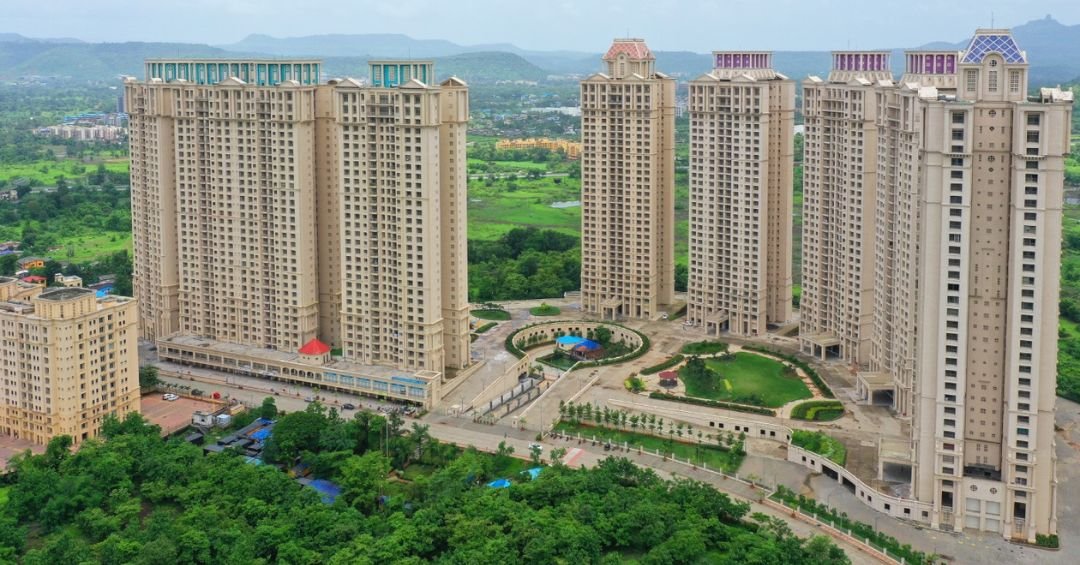
Pros and Cons of Paying Floor Rise Charges
✅ Advantages of Higher Floors
- Better city views and greenery outlook
- More natural light and ventilation
- Less pollution and noise
- Higher resale value in the long run
❌ Considerations Before Paying Extra
- Elevator Dependence: Higher floors mean greater reliance on lifts. Always check for multiple elevators in the project.
- Maintenance Costs: Premium floors sometimes carry higher monthly charges.
- Emergency Situations: During power outages, accessing higher floors may be inconvenient.
Are Floor Rise Charges Worth Paying in Thane?
Whether floor rise charges are worth it depends on your lifestyle, priorities, and budget.
- If you value panoramic views of Yeoor Hills or Thane Creek, it might be worth paying extra.
- If your priority is budget-friendliness, a mid-level floor can offer a balance between cost and comfort.
- For investment purposes, higher floors often fetch better resale prices, making the additional charges worthwhile.
Tips for Homebuyers in Thane
Before finalizing your flat, keep these points in mind:
- Ask for Floor Rise Slab: Check how the builder calculates charges (per sq. ft. per floor or flat slab rate).
- Compare Projects: Some developers keep these charges lower to attract buyers. Compare before deciding.
- Negotiate: In some cases, especially during pre-launch offers in Thane, you may negotiate to reduce or waive these charges.
- Check RERA Compliance: Always confirm the floor rise structure is clearly mentioned in the cost sheet and RERA filing.
Conclusion
Floor rise charges in Thane are a standard part of modern real estate pricing. While they add to the cost, they also reflect the added lifestyle benefits of living on higher floors. By understanding how these charges work, buyers can make smarter, more informed decisions about which floor offers the best balance of budget, comfort, and long-term value.
At Urvik Consulting, we guide homebuyers in Thane through every aspect of real estate transactions—right from understanding cost components like floor rise charges to finding the perfect property. With expert advice, you can be confident that your dream home in Thane is not only within budget but also a sound investment.
Benefits for Women Homebuyers in Thane in 2025 – A Complete Buying Guide
Table of Contents
Benefits for Women Homebuyers in Thane : Buying a home is one of the most significant milestones in life. For women in India, and especially in fast-growing urban hubs like Thane, property ownership represents financial independence, security, and empowerment. With Thane’s rapid development, excellent infrastructure, and booming real estate market, many women are now stepping forward to purchase homes for themselves and their families.
In 2025, both the government and financial institutions continue to encourage this trend by offering special benefits for women homebuyers in Thane. From lower stamp duty to tax deductions and loan concessions, these advantages make homeownership not only easier but also more rewarding.
Here’s a complete buying guide outlining the benefits and key considerations for women purchasing residential property in Thane.
1. Lower Stamp Duty Rates in Thane
Many states in India, including Maharashtra, provide reduced stamp duty rates for women buyers. For properties in Thane registered under a woman’s name, the difference can result in substantial savings.
💡 Example: In Delhi, women pay 4% stamp duty compared to 6% for men. Similarly, in Maharashtra, certain concessions apply for women buyers, making homes in Thane more affordable. On a ₹1 crore property, even a 1–2% reduction means savings of up to ₹2 lakh.
2. Concessions on Registration Charges
Apart from lower stamp duty, some states offer discounted registration fees when properties are registered in a woman’s name. For buyers looking at apartments in Thane, this concession further reduces the overall cost of purchase, especially in premium locations like Ghodbunder Road, Pokhran Road, and Kolshet Road.
3. Higher Loan Eligibility & Lower Interest Rates
Banks and housing finance companies extend special home loan benefits for women in Thane, including:
- Lower Interest Rates: Discounts of 0.05%–0.1% are common. For instance, Union Bank of India offers a 0.05% lower rate on loans for women.
- Higher Loan-to-Value Ratio (LTV): Women may get higher financing compared to men, making it easier to purchase bigger homes or invest in upcoming projects in Thane.
Over the loan tenure, these benefits translate into significant savings.
4. Tax Benefits for Women in Thane
Women homebuyers in Thane can avail income tax deductions just like anywhere else in India:
- Section 80C: Deduction up to ₹1.5 lakh on principal repayment.
- Section 24(b): Deduction up to ₹2 lakh on interest payments.
If a woman co-owns a property in Thane with her spouse and both are co-borrowers, each can claim these deductions separately, effectively doubling the tax benefits.
5. Empowerment & Financial Security
Owning a home in Thane strengthens a woman’s financial independence and decision-making power. With Thane’s real estate market steadily appreciating due to new infrastructure projects like the Thane Metro and Borivali–Thane Twin Tunnel, property ownership becomes both a lifestyle choice and a long-term financial investment.
Benefits include:
- Greater autonomy within the family
- Security through asset ownership
- Confidence in financial planning
- An asset that appreciates over time
6. Exclusive Benefits Under PMAY for Women in Thane
The Pradhan Mantri Awas Yojana (PMAY) offers further incentives for women buyers in Thane:
- Subsidies up to ₹2.67 lakh on home loans
- Mandatory co-ownership by at least one woman in the family to qualify
- Women in the EWS (Economically Weaker Section) and LIG (Lower Income Group) can get an interest subsidy of 6.5%
This makes it easier for women in Thane to buy affordable housing under new and upcoming projects.

Things Women Should Consider Before Buying a Home in Thane
While the benefits for women homebuyers in Thane are encouraging, here are key aspects to keep in mind:
1. Loan Affordability & EMI Planning
- Use a home loan EMI calculator before committing.
- Factor in additional costs such as society maintenance charges, Thane Municipal Corporation property tax, and insurance.
2. Property Location & Safety
- Choose safe and well-connected areas in Thane such as Majiwada, Ghodbunder Road, or Pokhran Road.
- Check proximity to schools, hospitals, and offices.
3. Legal Documentation
- Verify the title deed and ensure the property is free from disputes.
- For resale flats in Thane, confirm there are no pending loans or encumbrances.
4. Comparing Loan Offers
- Compare banks for interest rates, loan tenure, and processing charges.
- Check for flexibility in prepayments.
5. Insurance & Backup Planning
- Invest in home insurance for protection against natural calamities.
- Maintain an emergency fund for unexpected property-related expenses.
Also Read : Key Legal Checklist for Buying a Property in Thane
Conclusion
For women in 2025, buying a home in Thane is not just an emotional milestone but also a smart financial decision. With benefits like lower stamp duty, registration concessions, favorable home loans, tax deductions, and PMAY subsidies, women buyers in Thane are better positioned than ever to secure their dream homes.
Beyond financial perks, homeownership empowers women, enhances security, and creates long-term wealth. Given Thane’s infrastructure boom and rising property values, this is the right time for women to step into real estate ownership.
At Urvik Consulting, we help women homebuyers in Thane navigate every step of the process—from identifying the right property to understanding legal documentation and financing options. With the right guidance, women can make confident, informed, and profitable property decisions in 2025.
Upcoming Residential Projects in Thane You Should Watch Out For
Table of Contents
Thane has emerged as one of the fastest-growing real estate destinations in the Mumbai Metropolitan Region (MMR). Once known as a satellite city, it has now transformed into a modern urban hub with world-class infrastructure, business districts, and residential communities. With its excellent connectivity, growing employment opportunities, and abundance of green spaces, upcoming residential projects in Thane are attracting both end-users and investors.
If you are planning to buy a new home or invest in real estate, here’s a detailed look at the most promising projects and why Thane should be on your radar in 2025.
Why Thane is a Real Estate Hotspot
Before exploring the new launches, let’s understand what makes Thane one of the most preferred residential destinations:
- Connectivity: Thane is well connected to Mumbai, Navi Mumbai, and Kalyan via the Eastern Express Highway, Ghodbunder Road, and the upcoming Metro lines.
- Infrastructure: Upcoming projects like the Thane Metro, Mumbai Coastal Road, and Borivali–Thane Twin Tunnel will further improve accessibility.
- Lifestyle & Amenities: With top schools, healthcare facilities, malls, and IT parks, Thane offers a balanced lifestyle for families and professionals.
- Green Spaces: Known as the “City of Lakes,” Thane offers scenic surroundings with Yeoor Hills, Upvan Lake, and ample greenery.
- Real Estate Growth: Property values in Thane have steadily appreciated, making it a lucrative investment market.
Upcoming Residential Projects in Thane
Here are some of the noteworthy upcoming residential projects in Thane that homebuyers and investors should watch out for:
1. Hiranandani Estate – New Towers
One of the most reputed names in Thane real estate, Hiranandani is expanding its iconic township with new residential towers. Known for luxury living, premium amenities, and lush landscapes, this project is ideal for families looking for a high-quality lifestyle.
Highlights:
- Premium 2BHK & 3BHK apartments
- World-class clubhouse and sports facilities
- Located on Ghodbunder Road with excellent connectivity
2. Lodha Codename Crown Jewel, Majiwada
Lodha Group continues to redefine Thane’s skyline with another landmark project. Positioned at Majiwada, this project promises affordable luxury with modern design.
Highlights:
- Spacious residences with premium finishes
- Integrated township lifestyle with shopping and schools nearby
- Seamless connectivity to Mumbai via Eastern Express Highway
3. Rustomjee Uptown Urbania, Thane West
Rustomjee’s Urbania is already a landmark in Thane West, and its next phase will offer residents a mix of modernity and convenience.
Highlights:
- Smartly designed 2BHK homes
- Community-focused living with lifestyle amenities
- Proximity to schools, healthcare, and business hubs
4. Kalpataru Parkcity, Kolshet Road
Kalpataru’s Parkcity is one of the largest integrated townships in Thane. The upcoming phases are expected to bring more residential towers surrounded by parks and open spaces.
Highlights:
- 2BHK, 3BHK, and larger configurations
- Over 20 acres of green landscapes
- Sports arena, clubhouse, and lifestyle facilities
5. Raymond Realty – The Address by GS, Pokhran Road
Raymond Realty has gained significant traction in Thane’s premium housing market. Their new launches under “The Address by GS” continue to blend luxury with thoughtful planning.
Highlights:
- Elegant high-rise towers with modern interiors
- Close to malls, schools, and hospitals
- Excellent appreciation potential
6. Runwal Eirene, Balkum
Runwal Group is introducing new towers in its Eirene project, offering a mix of affordability and luxury.
Highlights:
- 1BHK to 3BHK configurations
- Family-friendly community living
- Strategic location near Balkum Naka
Key Locations to Watch in Thane
While choosing among these upcoming projects, the location is equally important. Some of the most promising micro-markets in Thane include:
- Ghodbunder Road: Known for connectivity and premium projects.
- Pokhran Road: Popular for luxury high-rises and proximity to business hubs.
- Majiwada: A central hub with excellent infrastructure.
- Kolshet Road: Emerging as a hotspot for integrated townships.
- Balkum & Manpada: Affordable and mid-segment housing options.
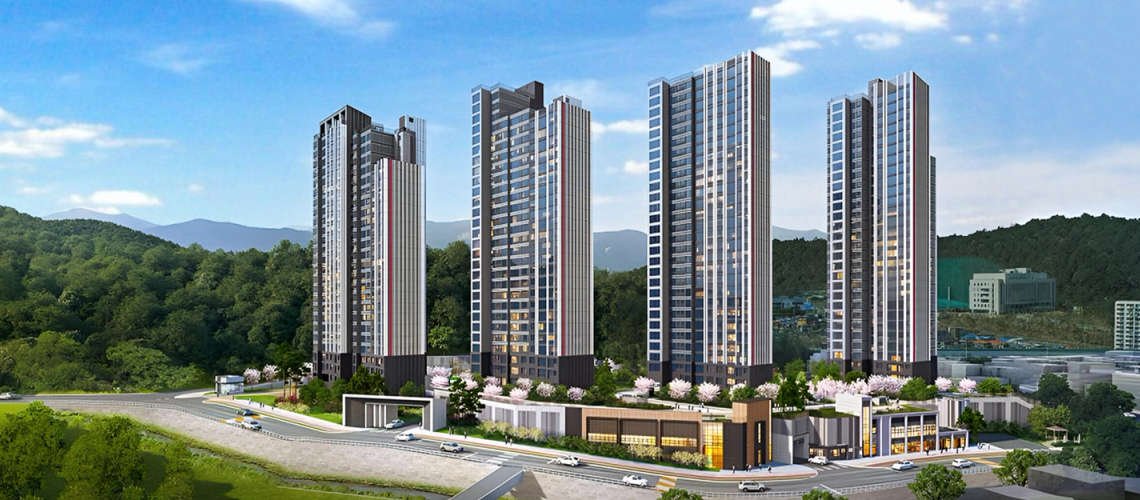
Why Invest in Upcoming Projects in Thane?
- Price Advantage: Buying in the pre-launch or launch phase often ensures lower pricing.
- Customization: Buyers may get flexible floor plans and interior options.
- Appreciation Potential: With upcoming infrastructure, property values in Thane are expected to rise.
- Modern Amenities: New projects focus on sustainable design, smart homes, and lifestyle amenities.
- Developer Reputation: Reputed builders like Lodha, Hiranandani, Kalpataru, and Rustomjee ensure quality and timely delivery.
Conclusion
Thane’s real estate market is entering an exciting phase with multiple upcoming residential projects from reputed developers. Whether you’re a first-time buyer, a family seeking a spacious home, or an investor looking for long-term returns, Thane offers a variety of options to match your needs.
From luxury high-rises on Pokhran Road to large integrated townships on Kolshet and Ghodbunder Road, the city has something for everyone. With strong infrastructure development and rising demand, investing in Thane today can secure both lifestyle benefits and financial growth in the future.
Wadala: Mumbai’s Next Central Business District
Table of Contents
Mumbai’s commercial heartbeat is shifting. With Bandra-Kurla Complex (BKC) reaching capacity, Wadala is emerging as the city’s next Central Business District (CBD). The Mumbai Metropolitan Region Development Authority (MMRDA) is preparing to auction 156 hectares of prime land in the area, opening the door for a new era of commercial growth.
Why Wadala is the Next Big Hub
For decades, BKC has been Mumbai’s premier corporate hotspot. But with no more land left for development, businesses and investors are looking for the next growth corridor. Wadala offers unmatched advantages:
- 🚆 Superior Connectivity: Eastern Freeway, Atal Setu, harbour railway, monorail, and the upcoming Metro-4 line make it one of the best-connected zones in Mumbai.
- 🏗️ Transit-Oriented Development: Planned as a smart, integrated business district.
- 🏙️ Urban Transformation: From a truck terminal to a high-rise business hub, Wadala is ready for reinvention.
Auction Buzz & Market Opportunity
The upcoming plot auctions are expected within the next 2–3 months. Developers are keen, especially after landmark deals in BKC such as Sumitomo Corporation’s ₹2,238 crore purchase. MMRDA aims to replicate that success, fueling Mumbai’s infrastructure while creating a world-class business hub.
What This Means for Investors & Businesses
Wadala is not just another real estate play—it’s a strategic opportunity:
- Early movers can secure premium plots at competitive pricing.
- Ideal for large-scale commercial, retail, and mixed-use projects.
- Long-term growth supported by Mumbai’s master planning and infrastructure pipeline.

The Road Ahead
Just as BKC rose from marshland to become a global business district, Wadala is set to redefine Mumbai’s corporate map. For businesses, developers, and investors, this is the moment to look beyond traditional hubs and position themselves at the forefront of Mumbai’s next growth story.
Buying a property in Thane is more than just a financial investment—it’s a lifestyle decision. But to truly enjoy the perks of homeownership, it’s crucial to be prepared for all the ongoing costs, not just your EMI or loan.
At Urvik Consulting, we go beyond just helping you find the right home—we help you plan for every stage of your real estate journey with expert financial and legal advice.
Whether you’re buying your first flat in Ghodbunder Road, investing in a premium apartment in Pokhran Road, or exploring under-construction projects near Kolshet, we’re here to guide you—every step of the way.

